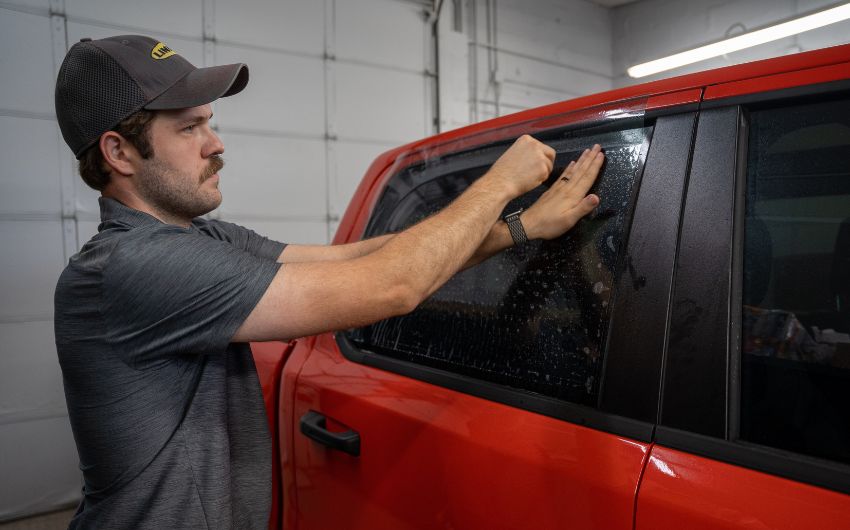Budget-friendly Auto Window Tinting for each Vehicle Type
Budget-friendly Auto Window Tinting for each Vehicle Type
Blog Article
Home Window Tinting Rules and Standards: What You Need to Know Prior To Tinting Your Vehicle
Prior to waging window tinting for your vehicle, it is vital to familiarize yourself with the varied regulations and guidelines that control this practice throughout various states. These guidelines determine the acceptable levels of tint darkness, frequently determined by visible light transmission (VLT) percents, and include specific terms for front windshields aimed at ensuring roadway safety. Furthermore, particular jurisdictions may provide clinical exemptions for people with qualifying conditions. Recognizing these complexities can save you from potential legal ramifications, but what are the specific guidelines in your state?
Introduction of Window Tinting Laws
Home window tinting regulations are regularly subject to variant throughout different territories, reflecting regional policies and safety considerations. These legislations determine the permitted levels of color darkness and reflectiveness on car home windows, making certain that chauffeurs maintain appropriate exposure while also safeguarding versus unsafe UV rays and warmth.
Many guidelines identify home window tinting based on the Visible Light Transmission (VLT) portion, which suggests the quantity of light that can go through the window. Normally, reduced VLT percents signify darker colors. Regulations usually set apart between the front, side, and back home windows, with stricter constraints related to the front windshield to improve safety and security for both the driver and various other roadway users.
Conformity with home window tinting laws is vital, as offenses can result in fines, obligatory removal of the color, and potential rises in insurance coverage costs. It is necessary for lorry proprietors to familiarize themselves with regional legislations before continuing with window tinting installments.
State-by-State Color Regulations
Understanding the details window tinting policies in each state is vital for car proprietors looking for to adhere to the regulation. Each state in the united state has established its very own collection of regulations governing home window tinting, which can differ dramatically. These regulations usually dictate the permitted degrees of color darkness, the kinds of windows that can be tinted, and any kind of clinical exceptions that might use.
As an example, states like California have rigorous limitations on tint darkness for front home windows, while others, such as New Mexico, may enable darker colors. In addition, specific states mandate details presence percents for various home windows, consisting of the windshield, front side windows, and rear windows. It is critical for car proprietors to familiarize themselves with their state's legislations to avoid prospective fines or fines.
Moreover, some states may call for an accreditation sticker label to be put on colored windows, showing compliance with state laws. Failing to abide by these laws not just risks legal repercussions yet can likewise influence safety and security and visibility while driving. Automobile owners must perform thorough study or seek advice from neighborhood authorities to ensure full understanding and conformity with state-by-state tint laws.
Allowed Color Types and levels
Several car owners might be stunned to find out that permitted tint levels and types differ widely across different states. Each state has actually try this site established its own laws pertaining to the permitted darkness and reflectivity of window tint, often determined by Visible Light Transmission (VLT) percents. VLT describes the amount of light that can travel through the tinted home windows; thus, a lower portion suggests a darker tint.

Additionally, the kinds of color products permitted can vary, with some states banning mirror-like or metallic coatings. It is necessary for car owners to acquaint themselves with their state's specific legislations to guarantee conformity. Non-compliance can lead to fines, compulsory removal of the tint, or various other legal effects, making it read this article important to recognize these guidelines prior to waging installment.
Medical Exemptions for Tinting
While not all states offer allowances for clinical exemptions regarding window tinting, those that do identify the requirement for particular people to boost exposure and comfort due to clinical problems. Numerous clinical conditions, such as lupus, skin cancer, and particular eye problems, can make individuals specifically delicate to sunlight. Subsequently, these people may call for darker tints to safeguard themselves from dangerous UV rays and glow.

It is essential to keep in mind that even with a clinical exception, there might still be restrictions on the level of color permitted. Compliance with state laws guarantees that people are both safeguarded and within legal limitations. Those thinking about clinical exceptions ought to call their neighborhood Division of Electric motor Autos or comparable authority to recognize the needs and procedures necessary to make an application for an exception efficiently.
Fines for Non-Compliance
Falling short to follow window tinting laws can result in considerable fines, which vary by state. Police are empowered to issue citations for automobiles that do not stick to the specified tinting guidelines. These charges normally consist Click This Link of penalties, which can range from small quantities to a number of hundred dollars, depending on the severity of the infraction and the state concerned.
In some territories, duplicated offenses might cause rising fines or added penalties, such as obligatory court looks. Furthermore, non-compliance might require the removal of unlawful tinting, typically at the owner's expenditure. In severe instances, habitual wrongdoers might encounter suspension of their car registration up until compliance is achieved.
In addition, insurance implications might emerge from receiving numerous citations for home window tint violations. Insurance providers may view such violations as an indication of riskier habits, potentially leading to raised costs or problem in coverage.
To prevent these fines, it is crucial for automobile owners to familiarize themselves with their local home window tinting legislations and ensure that their automobile complies (Window Tinting). This positive approach not just stays clear of lawful ramifications however additionally advertises roadway safety and security
Final Thought

Most policies categorize window tinting based on the Visible Light Transmission (VLT) percent, which shows the amount of light that can pass through the window. Compliance with window tinting laws is critical, as violations can result in fines, compulsory elimination of the tint, and possible boosts in insurance policy costs.Recognizing the particular window tinting guidelines in each state is crucial for vehicle owners looking for to abide with the legislation. These laws frequently determine the allowed levels of color darkness, the kinds of home windows that can be tinted, and any medical exemptions that may use.
For instance, states like The golden state have rigid limitations on tint darkness for front windows, while others, such as New Mexico, might allow darker tints.
Report this page